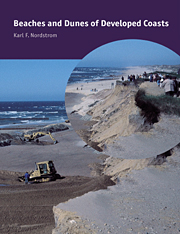Book contents
- Frontmatter
- Contents
- Preface
- Acknowledgements
- 1 The developed coastal landscape: temporal and spatial characteristics
- 2 Altering landforms to suit human needs
- 3 Replenishing landforms
- 4 Effects of structures on landforms and sediment availability
- 5 Characteristics of human-altered coastal landforms
- 6 Temporal scales of landscape change
- 7 Management programs
- 8 Maintaining and enhancing natural features in developed landscapes
- 9 Directions for geomorphological research
- References
- Index
8 - Maintaining and enhancing natural features in developed landscapes
Published online by Cambridge University Press: 18 December 2009
- Frontmatter
- Contents
- Preface
- Acknowledgements
- 1 The developed coastal landscape: temporal and spatial characteristics
- 2 Altering landforms to suit human needs
- 3 Replenishing landforms
- 4 Effects of structures on landforms and sediment availability
- 5 Characteristics of human-altered coastal landforms
- 6 Temporal scales of landscape change
- 7 Management programs
- 8 Maintaining and enhancing natural features in developed landscapes
- 9 Directions for geomorphological research
- References
- Index
Summary
Introduction
Previous chapters underscored the potential for eliminating landforms and ecosystems. It may be inevitable that human involvement in developed areas will continue to affect processes and landforms, but it is not inevitable that this involvement will be harmful to the beach (Flick 1993). Ways must be found to develop the shoreline to have both natural value and non-consumptive human use value. This chapter discusses ways that natural processes, landforms and ecosystems can be conserved or enhanced in relatively unaltered areas or restored in locations where natural environments have been severely altered or eliminated.
Values vs. degree of naturalness
The potential for modification of natural beaches and dunes to artifacts and the potential for restoration of coastal landscapes to more naturally functioning systems depends on human values for coastal resources and the perceived role of natural components in providing uses related to these values. The most commonly occurring human uses and their associated alterations may be placed in a continuum (Figure 8.1) to highlight those that are most natural. The headings on the vertical axis of Figure 8.1 are arranged according to the likelihood that the human alteration selected will result in natural or naturally functioning landforms. The human alterations are presented in the figure as mutually exclusive categories for simplicity of portrayal. They would not generally be considered mutually exclusive by coastal planners, although only one value may be emphasized in management programs, especially those programs conducted by local jurisdictions in small parcels of land.
- Type
- Chapter
- Information
- Beaches and Dunes of Developed Coasts , pp. 225 - 260Publisher: Cambridge University PressPrint publication year: 2000



